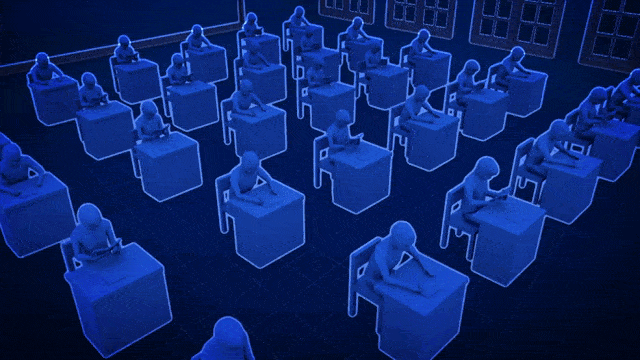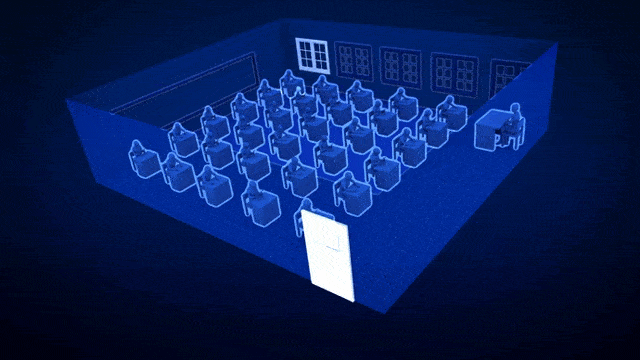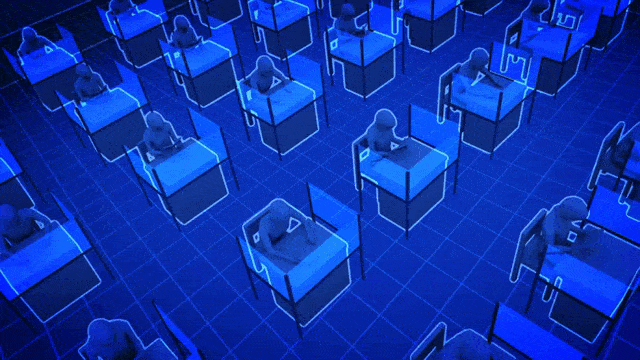As the new school year opens amid another coronavirus surge across the country, the delta variant is causing an unprecedented rise in pediatric COVID cases.
Fifteen percent of all new cases in the country are now in children, according to the American Academy of Pediatrics, and kids COVID-related hospital admissions per capita are at an all-time pandemic high.
As 56 million school children get back to the classroom, health experts say a multipronged defense system is critical: vaccines for those eligible, mask-wearing, hand-washing and social distancing. Also, robust ventilation systems and strategic seating arrangements will prevent poor air circulation from providing a convenient route for the virus to target new hosts.
GMA Investigates teamed up with Prof. Lydia Bourouiba, head of the Fluid Dynamics of Disease Transmission Laboratory at MIT, to visualize potential real-life instances of how COVID-19 can spread among students with just one positive COVID case in the room.
 GMA Investigates teamed up with Lydia Bourouiba, head of the Fluid Dynamics of Disease Transmission Laboratory at MIT, to visualize potential real-life instances of how Covid can spread among students with just one positive Covid case in the room -- and how schools can help curb transmission. (ABC News)
GMA Investigates teamed up with Lydia Bourouiba, head of the Fluid Dynamics of Disease Transmission Laboratory at MIT, to visualize potential real-life instances of how Covid can spread among students with just one positive Covid case in the room -- and how schools can help curb transmission. (ABC News)
By the end of a six-hour school day, one child infected with COVID -- whether they have symptoms or not -- sitting in the back of a maskless class can spread viral particles throughout the room.
"If we're not wearing a mask, that contamination is building up, particularly when we're in a classroom for hours," Bourouiba said. "But there are simple measures when we bring in fresh air from the outside that are very effective."
By opening a door at the front of class and opening a window at the back, on the opposite side, the circulation can help flush fresh air in and any viral particles out.
 MIT Professor Lydia Bourouiba explains an open door and window in the classroom can increase airflow, which helps flush out old air from the room and let fresh air flow in. But seating arrangement is also important - Bourouiba cautions not to put kids near either where the air is flowing in -- or where it's flowing out -- to avoid creating a potential transmission hot zone. (ABC News)
MIT Professor Lydia Bourouiba explains an open door and window in the classroom can increase airflow, which helps flush out old air from the room and let fresh air flow in. But seating arrangement is also important - Bourouiba cautions not to put kids near either where the air is flowing in -- or where it's flowing out -- to avoid creating a potential transmission hot zone. (ABC News)
The seating chart should be designed to work with that ventilation, not against it. Bourouiba explained students shouldn't sit in the way of the airflow's path because it could risk creating hot zones for transmission within the classroom. Bourouiba recommended placing children's desks at least 3 feet away from the open doors and windows.
"It's very important ... not to have a student or an individual sitting next to the inlet of fresh air, for example," Bourouiba said. "We would be extending the exhalation zone of the student sitting there, so if that individual turned out to be infected, that could be a problem."
Experts say there's no one secret to reducing COVID-19 transmission in schools and what works in one classroom might not work in another. Classroom size, the number of children and teachers and the ventilation of each room could all impact transmission.
The delta variant poses an even further challenge. CDC Director Dr. Rochelle Walensky has said someone infected with the original strain of COVID-19 could pass it on to two others, with transmissibility akin to the common cold. With the delta variant, however, the risk of spreading swells to at least five other people.
"Scientists are looking into exactly why this variant is especially dangerous, but what we think is that the delta variant is really effective at making copies of itself," said Dr. John Brownstein, an epidemiologist at Boston Children's Hospital and an ABC News contributor. "Every cough or sneeze has more virus particles, meaning that you can more easily infect other people when you're sick."
MORE: 12-year-old fights for mask mandate in schoolsSince each sneeze packs more of a punch with the delta variant, a layered approach is needed to control the virus's spread, experts say.
"A virus that spreads more efficiently means that it's harder to control and we use additional mitigation measures," Brownstein said. "When you bring kids back into school and there are gatherings in large auditoriums, lunchrooms, those are places where you can see spreading events. ... What we know is to protect our kids in schools, it comes down to layers of protection."
The CDC recommends all students ages 2 and older wear face masks indoors for the 2021-2022 school year, regardless of vaccination status. Experts say masks help block aerosol particles from being directly sprayed into the room and onto adjacent students.
"What we have found time and time again is that masking can limit the spread of transmission," Brownstein said. "Especially indoor settings like schools."
Experts additionally recommend testing in the classroom setting and vaccination for those eligible. For now, that means those who are 12 and older. Brownstein said "podding" smaller groups of students together to avoid mingling with additional classmates may help mitigate super-spreading events.
MORE: Why some states are pushing back on masks amid delta variant surgeBourouiba lays out her suggestions in a document, "Healthy Teaching Recommendations: In-person teaching in times of COVID-19" and says that school leadership can stagger student pods' snacks and meals, and kids can sit on the same side of the table, facing forward, to avoid breathing virus particles directly into their lunchmates' faces.
But all layers of protection are not alike. While plexiglass partitions have become a common sight during the pandemic -- at restaurants, checkout counters and office settings -- some experts caution against relying on plastic dividers.
 MIT Professor Bourouiba has advised schools around the world on how to curb Covid in the classroom, and says the plastic partitions that have popped up amid the pandemic may do more harm than good -- since while the dividers block larger droplets, they hinder good airflow and let any lingering viral particles hang around longer. (ABC News)
MIT Professor Bourouiba has advised schools around the world on how to curb Covid in the classroom, and says the plastic partitions that have popped up amid the pandemic may do more harm than good -- since while the dividers block larger droplets, they hinder good airflow and let any lingering viral particles hang around longer. (ABC News)
Bourouiba, who has advised schools on COVID precautions around the world and offers guidance on preparing for in-person learning on her website, "Healthy Teaching," said dividers can do more harm than good. While they're effective in blocking larger droplets, separators won't fully stop all viral particles from floating over and around the partition's edges. The plastic will instead inhibit good air circulation, Bourouiba said, allowing stagnant and potentially contaminated air to linger.
 Instead, Professor Bourouiba suggests staggering the desks so a student isn't seated directly in front of another student's breathing zone -- especially if they are unmasked. But, experts say improved room layout alongside masking is the best combination. (ABC News)
Instead, Professor Bourouiba suggests staggering the desks so a student isn't seated directly in front of another student's breathing zone -- especially if they are unmasked. But, experts say improved room layout alongside masking is the best combination. (ABC News)
"You're adding a number of obstacles that confine the space in all these little pockets," she said. "We are hindering the airflow mixing that we want to create."
ABC News' Eric M. Strauss, Sony Salzman, Dr. Mark Abdelmalek and Alex Myers contributed to this report.